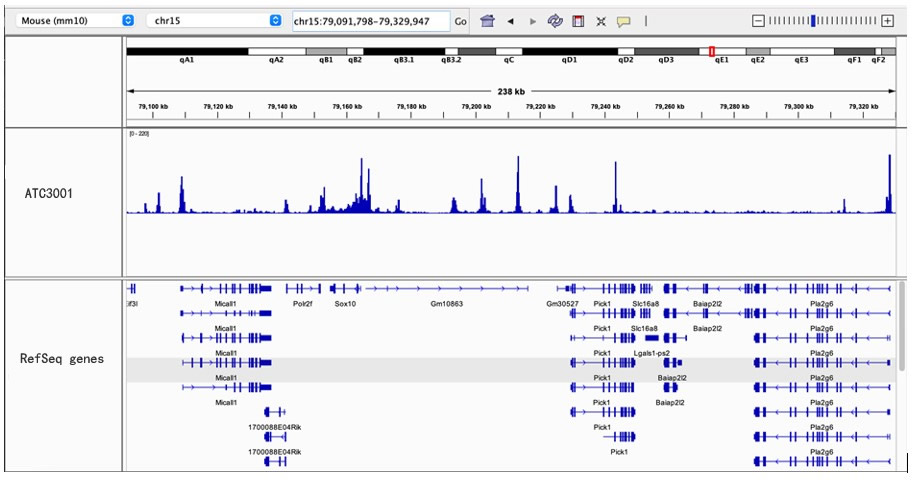Anti-Histone H3 (acetyl K9) antibody - ChIP, CUT&RUN and CUT&Tag Grade
Catalog number :ATC3001
Histone post-translational modifications (PTMs) are key mechanisms of epigenetics that modulate chromatin structures, termed as “histone code”. The PTMs on histone including acetylation, methylation, phosphorylation and novel acylations directly affect the accessibility of chromatin to transcription factors and other epigenetic regulators, altering genome stability, gene transcription, etc. Histone acetylation occurs primarily at multiple lysine residues on the amino-terminal of core histones, in response to various stimuli and plays vital roles in the regulation of gene expression, DNA damage repair, chromatin dynamics, etc. Mostly, histone H2A is primarily acetylated at Lys5, 9, 15, and 36; H2B is primarily acetylated at Lys5, 12, 15,16, and 20. Histone H3 is primarily acetylated at Lys4, 9, 14, 18, 23, 27, 56, and 79. Histone H4 is primarily acetylated at Lys5, 8, 12, 16, and 20. Histone acetyltransferases (HATs) and histone deacetylases (HDACs) are major regulating factors.
- Overview
- Description
- Anti-Histone H3 (acetyl K9) mouse monoclonal antibody - ChIP, CUT&RUN and CUT&Tag Grade
- Reactivity
- human,mouse,rat and a wide range of species
- Tested applications
- ChIP: 10-20ul per reaction
CUT&RUN: 2-10ul per reaction
CUT&Tag: 2-10ul per reaction
- Specificity
- Recognize H3K9ac specifically.
- Properties
- Immunogen
- Synthetic peptide with Histone H3K9ac. The exact sequence is proprietary.
- Clonality
- Monoclonal, clone number: 6C2
- Isotype
- mouse IgG
- Form
- Liquid, 100 μl,1mg/ml, PBS (pH 7.2) and 40% Glycerol,0.02% Sodium Azide
- Storage instruction
- Store at -20°C, Avoid freeze / thaw cycle.
- Host
- Mouse
- Positive Controls
- WB: HeLa (Human cervix adenocarcinoma epithelial cell), NIH/3T3 (Mouse embryonic fibroblast) and C6 (Rat glial tumor glial cell) treated with 500ng/ml Trichostatin A for 4 hours whole cell lysate IHC-P: Human cerebrum, colorectal carcinoma, mouse colon and rat colon tissue sections. ChIP: Chromatin prepared from HeLa cells. ChIP-seq: Chromatin prepared from HeLa cells. IP: HeLa cells. ICC/IF: HeLa cells. ChIC/CUT&RUN: HeLa cells.
- Applications
- Application Figure 1

CUT&RUN sequencing - Anti-Histone H3 (acetyl K9) antibodyCUT&RUN was performed using a pAG-MNase at a final concentration of 700 ng/mL, 2.5 x 10^5 HeLa (Human epithelial cell line from cervix adenocarcinoma) cells and 5 µg of antibody. The resulting DNA was sequenced on the Illumina NovaSeq 6000 to a depth of 10 million reads. The negative IgG control is also shown.
- Application Figure 2

CUT&RUN sequencing - Anti-Histone H3 (acetyl K9) antibodyCUT&RUN was performed using a pAG-MNase at a final concentration of 700 ng/mL, 2.5 x 10^5 HeLa (Human epithelial cell line from cervix adenocarcinoma) cells and 5 µg of antibody. The resulting DNA was sequenced on the Illumina NovaSeq 6000 to a depth of 10 million reads. The negative IgG control is also shown.
- Application Figure 3

ChIP-sequencing - Anti-Histone H3 (acetyl K9) antibodyChromatin was prepared from HeLa cells. Cells were fixed with 1% formaldehyde for 10 minutes. ChIP was performed with 30 µg of chromatin and 4 µg of Anti-Histone H3 (acetyl K9) antibody. ChIP DNA was sequenced on the Illumina NextSeq 500 to a depth of 30 million reads.
- Application Figure 4

CUT&Tag sequencing - Anti-Histone H3 (acetyl K9) antibodyCUT&Tag-seq was performed using 200,000 Oli-neu (Oligodendrocyte progenitor) cells. Cells were permeabilized with 0.05% Digitonin and 0.01% NP-40 for 3 minutes. A 1:100 dilution of Recombinant Anti-Histone H3 (acetyl K9) antibody was used, along with a rabbit anti-mouse Secondary. DNA was seg using Illumina NovaSeq S Prime to a depth of 22 million reads.
Related Products
Reviews
loading...